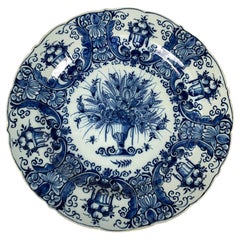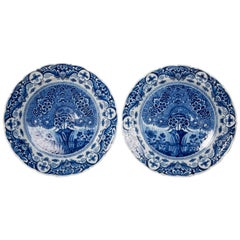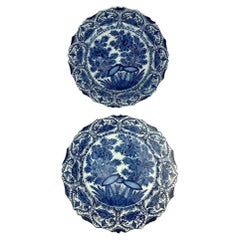1770s Delft and Faience
6
to
4
2
6
6
6
4
1
511
249
226
16
82
86
20
14
1
3
12
2
21
5
6
5
6
6
4
2
6
4
2
1
1
1
1
1
Period: 1770s
Blue and White Delft Charger Hand Painted 18th Century Circa 1770
By Delft
Located in Katonah, NY
Painted in the center with a vase filled with a lush bouquet of flowers.
The border is painted with six foliate scroll panels, each with a vase filled with fruits alternated by blue ...
Category
Dutch Rococo Antique 1770s Delft and Faience
Materials
Delft
Blue and White Delft Charger Hand Painted at The Axe Holland Circa 1770
By The Axe
Located in Katonah, NY
This blue and white charger was hand painted at De Porcelene Bijl* "The Axe" circa 1770.
The center of the charger is filled with a lovely flowering plant.
We see flowers in full blo...
Category
Dutch Rococo Antique 1770s Delft and Faience
Materials
Delft
Blue and White Delft Dishes Antique Pair Made circa 1770
Located in Katonah, NY
We are pleased to offer this pair of blue and white Dutch Delft dishes with lovely chinoiserie decoration, which features an image of a vase overflowing with flowers.
Around the vas...
Category
Dutch Chinoiserie Antique 1770s Delft and Faience
Materials
Delft
Ancient Maiolica Plates Pasquale Rubati, Milan Circa 1770-1780
Located in Milano, IT
Five oval maiolica dishes with pierced edge
Manufacture of Pasquale Rubati
Milan, 1770-1780
Three small oval dishes 10.23 in x 7.67 in (26 cm x 19.5 cm)
Two large oval dishes 10.82 in x 8.85 in (27.5 x 22.5 cm)
lb 3.5 (kg 1.8)
State of conservation: intact
The five dishes of different sizes have an oval shape, a mixtilinear edge and a molded polylobed shape with a surface enriched with a relief weave motif extending to the brim and forming a perforated basket...
Category
Italian Rococo Antique 1770s Delft and Faience
Materials
Maiolica
Four Italian Ancient Dishes, Lodi, circa 1770-1780
Located in Milano, IT
Assortment of 4 dishes with braided rim
Antonio Ferretti Manufacture
Lodi, circa 1770-1780
Maiolica polychrome decorated “a piccolo fuoco” (third fire).
Measures: 14 x 10 in (35.5 x 25.5 cm);
12.2 x 8.39 in (31 x 21.3 cm);
10.4 x 9.65 in (26.5 x 24.5 cm);
10.8 x 9.61 in (27.5 x 24.4 cm).
Weight: 4.4 lb (1.998 kg)
State of conservation: some chips due to use on the edges and on the parts in relief.
The four different dishes have a foot with a low lip from which extends a wide, flat, slanted rim resembling a basket weave. The small handles are painted green: they resemble wickerwork in the two oval dishes and take the form of a sinuous branch in the round ones.
The third fire decoration is inspired by the naturalistic floral botanical patterns on the ceramics produced by the Hannong family in Strasbourg. Here the pattern is defined by the rapidity and subtlety of the brushstrokes and the result is particularly tasteful, characterized by compositional intelligence and pictorial expertise.
A main corolla, either a wild or garden rose, is set slightly off center in each well. From this extends a thin stem holding a small secondary bud and there are small field florets dotting the composition to lend volume to the delicate bunch of flowers.
On the brim, small polychrome flowers add color to the weave, accompanied by lanceolate leaves of a very intense green.
There exist few and very rare examples for comparison with this morphology: a round plate - entirely consistent with those in question - has been dated to around 1775 (S. Levy, Maioliche settecentesche lombarde e venete, Milano 1962, tav. 200). Two other dishes with a basket rim, but with parallel striped brim decoration, were exhibited in the 1995 exhibition on Lodi ceramics; the attribution to the Lombard town near Milan is therefore almost exclusively derived from the decoration called "alla rosa contornata" or "alla vecchia Lodi" and constitutes one of the most popular decorations during the eighteenth century. (M. L. Gelmini, in Maioliche lodigiane del '700 (cat. mostra Lodi), Milano 1995, pp. 31 p. 162-163 nn. 181-182).
This decorative choice represented a strong point of the Lodi factory, which established itself thanks to the vivid nature of the colors made possible by the introduction of a new technique perfected by Paul Hannong in Strasbourg and which Antonio Ferretti introduced in Italy. This production process, called “piccolo fuoco” (third fire), allowed the use of a greater number of colors than in the past; in particular, the purple of Cassius, a red made from gold chloride, was introduced. Its use allowed for many more tones and shades, from pink to purple.
The Ferretti family had started their Maiolica manufacturing business in Lodi in 1725.
The forefather Simpliciano had started the business by purchasing an ancient furnace in 1725 and, indeed, we have evidence of the full activity of the furnaces from April of the same year (Novasconi-Ferrari-Corvi, 1964, p. 26 n. 4). Simpliciano had started a production of excellence also thanks to the ownership of clay quarries in Stradella, not far from Pavia. The production was so successful that in 1726 a decree of the Turin Chamber came to prohibit the importation of foreign ceramics, especially from Lodi, to protect internal production (G. Lise, La ceramica a Lodi, Lodi 1981, p. 59).
In its initial stages, the manufacture produced maolicas painted with the “a gran fuoco” (double fire) technique, often in turquoise monochrome, with ornamentation derived from compositional modules in vogue in Rouen in France. This was also thanks to the collaboration of painters like Giorgio Giacinto Rossetti, who placed his name on the best specimens next to the initials of the factory.
In 1748 Simpliciano made his will (Gelmini, 1995, p. 30) appointing his son Giuseppe Antonio (known as Antonio) as universal heir. After 1750, when Simpliciano passed away, Antonio was directly involved in the Maiolica factory, increasing its fortunes and achieving a reputation on a European level. Particularly important was the aforementioned introduction in 1760 of the innovative “a piccolo fuoco” (third fire) processing, which, expanding the ornamental repertoire with Saxon-inspired floral themes, could commercially compete with the German porcelains that had one of its most renowned offerings in the naturalistic Deutsche Blumen. Antonio Ferretti understood and promoted this technique and this decoration, proposing it in a fresher and more corrective version, less linked to botanical tables...
Category
Italian Neoclassical Antique 1770s Delft and Faience
Materials
Maiolica
Blue and White Delft Chargers Theeboom Pattern made by "The Claw" circa 1770
By De Klaauw
Located in Katonah, NY
This pair of Dutch Delft chargers in the "Theeboom" pattern shows a tea plant with a fan-shaped bouquet of leaves and flowers.
The deep cobalt blue is fabulous!
This is one of the ...
Category
Dutch Rococo Antique 1770s Delft and Faience
Materials
Delft
Related Items
Delft - Chinoiserie style Charger by De Claauw, mid 18th century
By Delft
Located in DELFT, NL
Mid 18th century Blue Delftware charger with Chinoiserie decor of 'precious gifts'.
Marked 'De Claauw'
Mid 18th century
Good quality of painting
Good condition; chips and usual wea...
Category
Dutch Chinoiserie Antique 1770s Delft and Faience
Materials
Earthenware, Delft, Faience
18th Century Dutch Delft De Lampetkan Blue and White Cabinet Plate Tullips
Located in Wommelgem, VAN
Large Dutch Delft cabinet plate - Delftware plate
Material: Delft, earthenware , pottery, tin glaze
Design: De Lampetkan
Producer: De Lampetkan also known as De Porceleyne Lampetk...
Category
Dutch Rococo Antique 1770s Delft and Faience
Materials
Earthenware, Pottery, Delft
Free Shipping
H 1.9 in W 13.6 in D 13.6 in
Early 18th Century Blue and White Dutch Delft Clobbered Vase
Located in Fort Lauderdale, FL
A blue and white Dutch delft vase made circa 1700, with clobbered-style polychrome enamels added in the mid-18th century.
This brightly colored blue and white Dutch delft vase is a ...
Category
Dutch Dutch Colonial Antique 1770s Delft and Faience
Materials
Delft, Pottery
Large 19th Century Dutch Hand-Painted Blue and White Ceramic Delft Cachepot
By Delft
Located in Dallas, TX
This elegant antique faience planter was created in Holland, circa 1880. Round in shape with bowed movement, the cachepot stands on small shell...
Category
Dutch Antique 1770s Delft and Faience
Materials
Faience, Porcelain
Pair of Mid-20th Century Dutch Painted Blue and White Faience Delft Ginger Jars
By Delft
Located in Dallas, TX
Place this elegant pair of antique ceramic ginger jars on a mantel or a console in entryway. Crafted in Holland, circa 1960, the traditional blue and white jars are round in shape an...
Category
Dutch 1770s Delft and Faience
Materials
Ceramic, Faience
Blue and White Dutch Delft Tile with Carnation, 17th Century
Located in AMSTERDAM, NH
The Netherlands
Circa 1660 – 1680
A blue and white Dutch tile with the decoration of two carnations. One in the bud and one in bloom.
With small oxheads as corner decoration.
The t...
Category
Dutch Baroque Antique 1770s Delft and Faience
Materials
Ceramic, Faience, Majolica
Free Shipping
H 4.89 in W 4.89 in D 0.44 in
Blue and White Dutch Delft Tile with Cat, Mid 17th Century
Located in AMSTERDAM, NH
The Netherlands
Circa 1630 - 1660
A rare blue and white tile with the decoration of a nice large cat with big whiskers!
Cats are quite rarely depicted on tiles, why is unknown.
Wi...
Category
Dutch Baroque Antique 1770s Delft and Faience
Materials
Ceramic, Faience, Majolica
Free Shipping
H 5.16 in W 5.16 in D 0.44 in
18th Century French Blue and White Hand Painted Faience Delft Vase
By Delft
Located in Dallas, TX
This important antique vase was crafted in France, circa 1780. Octagonal in shape with gadrooned body style and a tall neck, the elegant potiche features a hand painted medallion dep...
Category
French Louis XV Antique 1770s Delft and Faience
Materials
Ceramic, Faience
18th Century Delft Chinoiserie Charger
Located in Pasadena, CA
This is a good example of a mid-18th century Delft charger in a chinoiserie hand-painted pattern. The pottery is hand-painted in a traditional blue and white chinoiserie scene featur...
Category
Dutch Chinoiserie Antique 1770s Delft and Faience
Materials
Faience
Set of 5 Circa 1900 Blue and White Delft Vases from Holland
Located in Dallas, TX
A beautiful set of five blue and white Delft vases, this faience collection was hand-painted in Holland, circa 1900. The three bulbous vases are lidded, each with a finial depicting a rampant lion with a ball in its forepaws. Beneath the lion is a mottled background (on the front side only), with a foliate and floral margent. Each vase has the same scene painted on the front of the main body: a couple walking through a field surrounded by flowers. The opposite side has a floral rinceaux above a foliate branch. Painted in a similar fashion, the two concave vases are without lids. The side opposite from the cartouche of the couple has floral margents. All five vases have canted corners on the base.
Inspired by Italian majolica, the faience produced in 16th century Holland...
Category
Dutch Antique 1770s Delft and Faience
Materials
Delft, Paint
Blue and White Dutch Delft Tile with Pikier, Mid 17th Century
Located in AMSTERDAM, NH
The Netherlands
Amsterdam
Circa 1625 – 1650
A blue and white Dutch tile with a decoration of a Dutch soldier from the period of the 80 Years War. This soldier could be a member of t...
Category
Dutch Baroque Antique 1770s Delft and Faience
Materials
Ceramic, Faience, Majolica
Free Shipping
H 5.12 in W 5.12 in D 0.52 in
Delft 1760-1780 Blue and White Duynkerker Tobacco Jar Delftware
By Delft
Located in ROSSUM, GE
Blue and white DUYNKERKER tobacco jar
Delft, 1760-1780
The ovoid tobacco jar with copper lid has a groove on the shoulder at the top and a protruding rim. The jar is painted in blue...
Category
Dutch Baroque Antique 1770s Delft and Faience
Materials
Ceramic, Faience
Previously Available Items
Large Blue and White Delft Charger Hand Painted at The Axe Holland Circa 1770
By The Axe
Located in Katonah, NY
This large blue and white charger was hand painted at De Porcelene Bijl* "The Axe" circa 1770.
The center of the charger is filled with a...
Category
Dutch Rococo Antique 1770s Delft and Faience
Materials
Delft
Set of Two Blue and White Delft Chargers Hand Painted at The Axe Holland C-1770
By The Axe
Located in Katonah, NY
This set of two blue and white chargers was hand painted at *De Porcelene Bijl "The Axe" circa 1770.
The center of each charger is filled with a lovely flowering plant.
We see flower...
Category
Dutch Rococo Antique 1770s Delft and Faience
Materials
Delft
Blue and White Dutch Delft Plate Hand Painted 18th Century "The Claw" Holland
By The Claw
Located in Katonah, NY
Working in the factory of The Claw, the artist who painted this large dish used medium and dark cobalt blue to create a luxurious and beautiful chinoiserie garden scene.
The center ...
Category
Dutch Chinoiserie Antique 1770s Delft and Faience
Materials
Delft
Pair Blue and White Dutch Delft Chargers with Songbirds Made Circa 1770
Located in Katonah, NY
This pair of 18th-century Dutch Delft blue and white chargers were hand-painted. They feature beautiful long-tailed songbirds resting on a flowering branch.
The garden is lush with ...
Category
Dutch Rococo Antique 1770s Delft and Faience
Materials
Delft
Dutch Delft Plate with Earthquake Memorial Text, 18th Century
Located in AMSTERDAM, NH
City: Delft
Workshop: De Witte Starre
By: Dirck van den Berg
Date: 1776 - 1793
Plate made in memory of the earthquake of February 18th 1756 in Düren, Germany. This earthquake w...
Category
Dutch Rococo Antique 1770s Delft and Faience
Materials
Ceramic, Faience
English Delft Earthenware Charger Likely London circa 1770
Located in Hallowell, US
13.5" diameter. Having blue decoration in the Chinese taste, attributed to London factory in the 18th C. Normal rim frits as seen in the images. $850 tag but I need to sell it so I a...
Category
English Georgian Antique 1770s Delft and Faience
Materials
Pottery
Large Antique Blue and White Delft Charger Made, Late 18th Century, circa 1770
Located in Katonah, NY
We are proud to present this large blue and white delft charger. It was made in the Netherlands, circa 1770. The center decoration is a traditional 18th century "thousand flowers" de...
Category
Dutch Rococo Antique 1770s Delft and Faience
Materials
Delft
St. Clément Figure of a Young Man Going to Market France, circa 1775
Located in Katonah, NY
Provenance: From the collection of William and Marilyn (Milton) Simpson. Marilyn Simpson was a grandchild of John D. Rockefeller Jr. The paper label on the underside of the figure st...
Category
French Rococo Antique 1770s Delft and Faience
Materials
Faience
Pair of Dutch Delft Blue and White Chargers with Songbirds Made circa 1770
Located in Katonah, NY
A pair of 18th century Dutch Delft blue and white hand-painted chargers each showing a songbird resting on a flowering branch. The garden is lush with flowers. The artist has capture...
Category
Dutch Rococo Antique 1770s Delft and Faience
Materials
Delft
Delft Blue and White Charger 18th Century Showing Flowers in a Wheat Field
Located in Katonah, NY
An antique Dutch Delft blue and white charger, dating circa 1770.
The centre of this charger features a unique motif of three flowers in a stylized wheat field.
Surrounding the cen...
Category
Dutch Rococo Antique 1770s Delft and Faience
Materials
Delft
Pair of Delft Jars Blue and White, 18th Century
Located in Katonah, NY
A pair of octagonal Dutch delft covered jars painted in a beautiful shade of cobalt blue. Made in the 18th century, circa 1770, the jars have hand-painted panels with delicate chinoi...
Category
Dutch Chinoiserie Antique 1770s Delft and Faience
Materials
Delft
Pair of Blue and White Delft Chargers
Located in Katonah, NY
A pair of 18th century blue and white Dutch Delft chargers decorated with dragons.
The mythical dragon in the center of these chargers is a rare motif on Delft plates. It has an open...
Category
Dutch Chinoiserie Antique 1770s Delft and Faience
Materials
Delft
Recently Viewed
View AllMore Ways To Browse
17th Century Dutch Silver
Dutch Chinoiserie
Antique Delft Pottery And Glass
Antique Delft Charger
Delft Tin Glazed
Delft Blue Plates
Chinoiserie Dutch
Antique Blue And White Faience
Vintage Blue Delft
Antique Delft Blue And White
Framed Delft
Delft China
17th Century Chinoiserie
Dutch Polychrome
Yellow Delft
Charger Pair
Cobalt Blue Pots
Antique Dutch Tins







